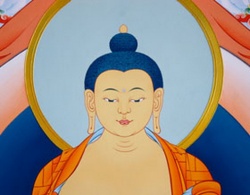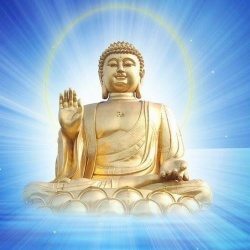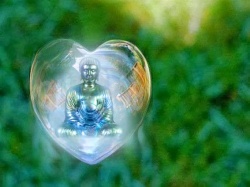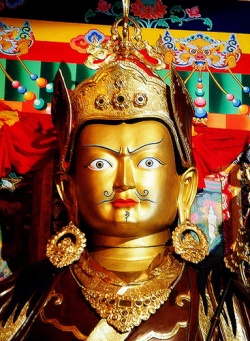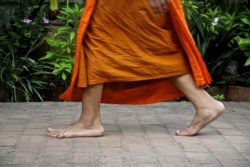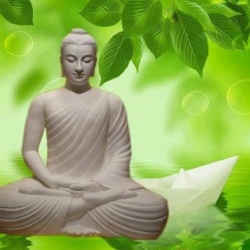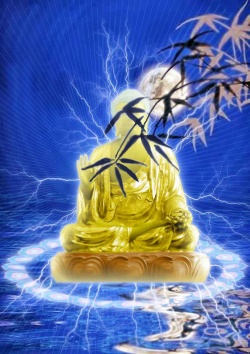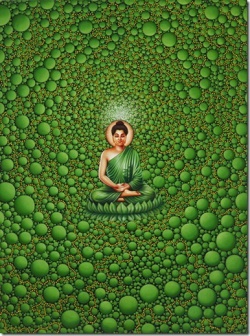Manual of Abhidharma - Reading Eight: Most Basic Virtue, and the Projecting and Finishing Energy of Deeds
The following selections are from the First Dalai Lama’s commentary to the Treasure House of Knowledge (Abhidharmakosha), entitled Illumination of the Path to Freedom. They include the root text of Master Vasubandhu.
80
How Most Basic Virtue is Lost
Most basic lost by the view they don’t exist;
Taken in the desire, had from birth.
Through the one denying cause and effect,
And through all. In stages, among humans,
Lost by those who are male or female, by the
Intellectual. This is not to have it.
[IV.313-8]
One may ask just what kind of non-virtue can make one lose his most basic virtue. The most basic virtue that a person possesses is lost by the view that certain important objects don’t even exist.
One may next ask how the process occurs. Most basic virtue which is taken in by the realm of desire can be lost, but not that which is taken in by the form or formless realms. This is because the types of views required can never appear in the mental streams of the beings of these realms.
Even among the most basic virtues included in the realm of desire, only those which one had from birth can be lost—never those which have been acquired by applying some efforts in practice. This is because these latter types of virtue are gone by the time the mistaken views involved have even reached a minor stage of minor intensity. They have been lost because the hold retaining them was lost.
As for the type of mistaken view involved, a person loses his most basic virtue through the one denying the principles of cause and effect. It is not however the view that realized beings do not exist which causes one to lose his most basic virtues.
Now some make the claim that views involving unstained phenomena or levels which are not comparable cannot cause a person to lose his most basic virtues. The fact though is that this virtue can be lost through all the forms of this view: through those that focus on levels that are comparable or those which are not; through those that focus on unstained phenomena or on those with stain. How exactly does the loss occur? Some claim that a person loses his most basic virtue all at once, the same way he loses all the undesirable objects that the path of seeing eliminates, once he gains this path. What actually happens though is that the virtue is lost in stages, the same way one loses the undesirable objects eliminated by the path of habituation.
One may next ask what kind of being can lose his basic virtue. Such a loss can occur among humans of the three continents, but not among other types of beings. The afflicted mental capacity of hell beings lacks the necessary stability, and the same lack of stability characterizes the non-virtuous thoughts of humans on the continent of Terrible Sound. Pleasure beings in the realms of desire and form are beings who see the three conditions directly; the principles of cause and effect are evident to them therefore, just after their birth.
Even among humans, basic virtue is lost by those who are male or female—not by those who have lost their sexual organ, or who never had one. This is because non-virtuous thoughts in the minds of such beings are never very stable.
Humans in general can be divided into two types: the more intellectual, and the more sensual. It is the former of the two that can lose this virtue, for they are capable of sustained intellectual activity marred by mental afflictions. The basic nature of this loss or what we call “cut-off” of a person’s most basic virtue is simply not to have it.
81
How Most Basic Virtue is Regained
Regained by suspecting, view there are;
Not in this, when immediate’s done.
[IV.319-20]
“What,” one may ask, “can help a person regain his most basic virtue after he has lost it?” This virtue can first be regained simply by suspecting that the principles regarding deeds and their results may actually exist. It can also be regained by gaining the correct view, whereby one actually perceives that there really are such principles.
One may ask whether it is always certain that a person will be able to regain his most basic virtue in the same life that he lost it. The answer is that he does not regain the virtue in this same life when he has done any of the “immediate” type of wrong deeds.
“When then,” one may ask, “does such a person regain his basic virtue?” If he originally lost this virtue because of some main cause, then the person regains it once he dies and migrates out of his hell birth. If on the other hand it was only some secondary factor that made him lose the virtue, then he regains it when he takes his hell birth.
94
The Projecting Energy of Deeds
A single one projects a single birth.
[IV.377]
Does a single deed project but a single birth, or many different births? And do a number of deeds project a number of births, or just a single birth? The answer is that a single deed projects a single birth; it cannot project a number of births. And since they would function to project a whole group of similar births, a number of deeds on the other hand is never something that projects but a single birth. This by the way is all the Detailist system.
Now someone may object that this description contradicts the following quotation from the Sutra of Sovereignty—
The elder, Aniruddha, spoke to the monks as follows:
“Venerable monks, I once took a birth in Varanasi, as a poor man whose job it was to collect straw for use as fuel. The poor man made the traditional offerings of food to a Self- Made Buddha by the name of Tengnesam [?], who was also known as `the one with the top center part of his head protruding like a takar flower.’
“My one act of giving away these offerings ripened into a birth as a pleasure being in the Land of the Thirty-Three. I was born there a total of seven times, and then took another seven births as a Wheel Emperor. And still it continues now, with my present birth into the wealthier class of the Shakyas.”
Yet there is no contradiction: the process was as follows. His offerings brought the poor man the good fortunes of a happier birth; later, he recalled what had brought him this state. These recollections themselves brought him still further merit. Thus although we can say that the one act of merit brought him such and such different births, what we really mean is that he achieved these births through a process that began with the one act. It’s like saying “I got rich on a single dong-tse [an amount of money)” when what you really did was start with a single dong-tse and turn it over in a great many business deals until eventually you became wealthy.
You could also say that the poor man started with the one instance of offering food and that it caused numerous instances of gladness and rejoicing over the act; these are themselves deeds consisting of a movement of the mind, and the many births can be said to have resulted from them.
95
Those that act to finish them off are many.
[IV.378]
It is but a single energy of deeds that projects a birth having a nature consistent with the deed; those deeds though that act to finish off the finer details of this future life are many. A master painter for example can sketch out the canvas with a single piece of chalk, and then a number of other people can come and fill it in with various different colors.
Any given group of people is similar in being human, but some of them who’ve had the details of their lives finished by virtuous deeds will have more attractive bodies, all their senses complete, greater material wealth, freedom from illness, positions of greater authority, and so on. Others in the same group who’ve had the details of their lives finished by non-virtuous deeds will have bodies with a repulsive appearance and so on.
Thus we can say that all four combinations between the two are possible: projection of a life by virtue but finishing by non-virtue, the reverse, a case where both are virtue, and a case where both are non-virtue. An example of the first would be persons born as pleasure beings or humans but who possessed certain sufferings.
An illustration of the second would be either the “Lord of All Things”—the Lord of Death—or the kings of the serpent-like nagas, those like the “Prince of Opulence.” An example of the third combination would be “Hundred Offerings”—lord of the great pleasure beings. And a case of the final combination would be the beings in the lowest hell, known as “No Respite.” The Sutrists and others assert though that there are many explanations, in a number of different sutras, that a single deed can project multiple rebirths. Therefore, they say, a single deed can project many births and a number of deeds can as well project a single birth.
96
Deeds that do not Project a Life
The balanced meditations that stop the mind
Never act to project; neither do holds.
[IV.379-80]
One may ask whether every different kind of deed can function to project a new life. The answer is that the two balanced meditations that stop the mind never act to project a life, even though they do come with the “ripened” sorts of results. This is because the lives in question have already been projected, by the fourth concentration level and the “peak” level. Moreover, beings in these states have no mind—and deeds that do not occur together with a movement of the mind are of very little force.
Thus we can say the expression that “the two balanced meditations ripen into the long life of a pleasure being, or into a life at the peak level” refers only to their function in finishing the final details of such rebirths. The projecting force though is something supplied by the fourth level of concentration and the “peak” level of existence.
Neither do holds, whether they be virtuous or non-virtuous, act to project a life—even when they occur together with a particular deed. First of all, the deed and the hold have different results. Secondly, the hold is only an incidental occurrence, for it does not involve a movement of the mind. It is therefore of very little force. Finally, the hold is to the deed as the bark is to the tree—something distinctly separate.
Holds however which constitute either virtue with stain or non-virtue do function to finish off the details of a given life. Just so examples of stained deeds that are present in the mental stream of a realized being, as well as the four stages of the peak of preparation (which we also call the “path that leads to certain separation”) function only as “finishing” types of energy.
See also
- Manual of Abhidharma - Reading One: Introduction to Abhidharma
- Manual of Abhidharma - Reading Two: The Nature of Karma, and What it Produces; the Detailist Concept of ''Non-Communicating Form''
- Manual of Abhidharma - Reading Three: Types of Deeds, and the Nature of Motivation
- Manual of Abhidharma - Reading Four: The Correlation of Deeds and Their Results
- Manual of Abhidharma - Reading Five: How Karma is Carried, According to the Mind- Only School
- Manual of Abhidharma - Reading Six: How Emptiness Allows Karma to Work, According to the Middle-Way School
- Manual of Abhidharma - Reading Seven: Black and White Deeds, the “Path of Action,” and the Root and Branch Non-Virtues
- Manual of Abhidharma - Reading Eight: Most Basic Virtue, and the Projecting and Finishing Energy of Deeds
- Manual of Abhidharma - Reading Nine: The Five Immediate Misdeeds, and the Concept of a Schism
- Manual of Abhidharma - Reading Ten: The Relative Severity of Deeds and What Causes It
- Manual of Abhidharma - Additions Part 1
- Manual of Abhidharma - Additions Part 2
